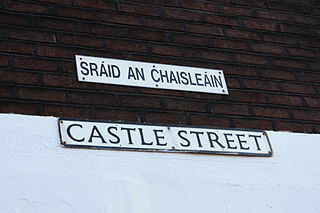
Breton is a Southwestern Brittonic language of the Celtic language group spoken in Brittany, part of modern-day France. It is the only Celtic language still widely in use on the European mainland, albeit as a member of the insular branch instead of the continental grouping.
In linguistics, an alternation is the phenomenon of a morpheme exhibiting variation in its phonological realization. Each of the various realizations is called an alternant. The variation may be conditioned by the phonological, morphological, and/or syntactic environment in which the morpheme finds itself.
Sandhi is any of a wide variety of sound changes that occur at morpheme or word boundaries. Examples include fusion of sounds across word boundaries and the alteration of one sound depending on nearby sounds or the grammatical function of the adjacent words. Sandhi belongs to morphophonology.
Brithenig, or also known as Comroig, is an invented language, or constructed language ("conlang"). It was created as a hobby in 1996 by Andrew Smith from New Zealand, who also invented the alternate history of Ill Bethisad to "explain" it. Officially according to the Ill Bethisad Wiki, Brithenig is classified as a Britanno-Romance language, along with other Romance languages that displaced Celtic.
In linguistics, lenition is a sound change that alters consonants, making them more sonorous. The word lenition itself means "softening" or "weakening". Lenition can happen both synchronically and diachronically. Lenition can involve such changes as voicing a voiceless consonant, causing a consonant to relax occlusion, to lose its place of articulation, or even causing a consonant to disappear entirely.
Consonant mutation is change in a consonant in a word according to its morphological or syntactic environment.
Jutlandic, or Jutish, is the western variety of Danish, spoken on the peninsula of Jutland in Denmark.

Irish, like all modern Celtic languages, is characterized by its initial consonant mutations. These mutations affect the initial consonant of a word under specific morphological and syntactic conditions. The mutations are an important tool in understanding the relationship between two words and can differentiate various meanings.

The Tunica or Luhchi Yoroni language is a language isolate that was spoken in the Central and Lower Mississippi Valley in the United States by Native American Tunica peoples. There are no native speakers of the Tunica language, but as of 2017, there are 32 second language speakers.
Middle Welsh is the label attached to the Welsh language of the 12th to 15th centuries, of which much more remains than for any earlier period. This form of Welsh developed directly from Old Welsh.
The morphology of the Welsh language has many characteristics likely to be unfamiliar to speakers of English or continental European languages like French or German, but has much in common with the other modern Insular Celtic languages: Irish, Scottish Gaelic, Manx, Cornish, and Breton. Welsh is a moderately inflected language. Verbs inflect for person, number, tense, and mood, with affirmative, interrogative, and negative conjugations of some verbs. There is no case inflection in Modern Welsh.
This article describes the grammar of the Scottish Gaelic language.
Breton is a Brittonic Celtic language in the Indo-European family, and its grammar has many traits in common with these languages. Like most Indo-European languages it has grammatical gender, grammatical number, articles and inflections and, like the other Celtic languages, Breton has mutations. In addition to the singular–plural system, it also has a singulative–collective system, similar to Welsh. Unlike the other Brittonic languages, Breton has both a definite and indefinite article, whereas Welsh and Cornish lack an indefinite article and unlike the other extant Celtic languages, Breton has been influenced by French.
Baiso or Bayso is an Afro-Asiatic, more specifically a Lowland East Cushitic language belonging to the Omo-Tana subgroup, and is spoken in Ethiopia, in the region around Lake Abaya.
Sanskrit has inherited from its reconstructed parent the Proto-Indo-European language an elaborate system of nominal morphology. Endings may be added directly to the root, or more frequently and especially in the later language, to a stem formed by the addition of a suffix to it.
The morphology of the Welsh language shows many characteristics perhaps unfamiliar to speakers of English or continental European languages like French or German, but has much in common with the other modern Insular Celtic languages: Irish, Scottish Gaelic, Manx, Cornish, and Breton. Welsh is a moderately inflected language. Verbs conjugate for person, tense and mood with affirmative, interrogative and negative conjugations of some verbs. A majority of prepositions inflect for person and number. There are few case inflections in Literary Welsh, being confined to certain pronouns.
Ske is an endangered language of south-western Pentecost island in Vanuatu. Ske is an Oceanic language.
Malayalam is one of the Dravidian languages and has an agglutinative grammar. The word order is generally subject–object–verb, although other orders are often employed for reasons such as emphasis. Nouns are inflected for case and number, whilst verbs are conjugated for tense, mood, and causativity. Malayalam adjectives, adverbs, postpositions, and conjunctions do not undergo any inflection; they are invariant.
Telugu is an agglutinative language with person, tense, case and number being inflected on the end of nouns and verbs. Its word order is usually subject-object-verb, with the direct object following the indirect object. The grammatical function of the words are marked by suffixes that indicate case and postpositions that follow the oblique stem. It is also head-final and a pro-drop language.
This article describes the grammar of the Old Irish language. The grammar of the language has been described with exhaustive detail by various authors, including Thurneysen, Binchy and Bergin, McCone, O'Connell, Stifter, among many others.



